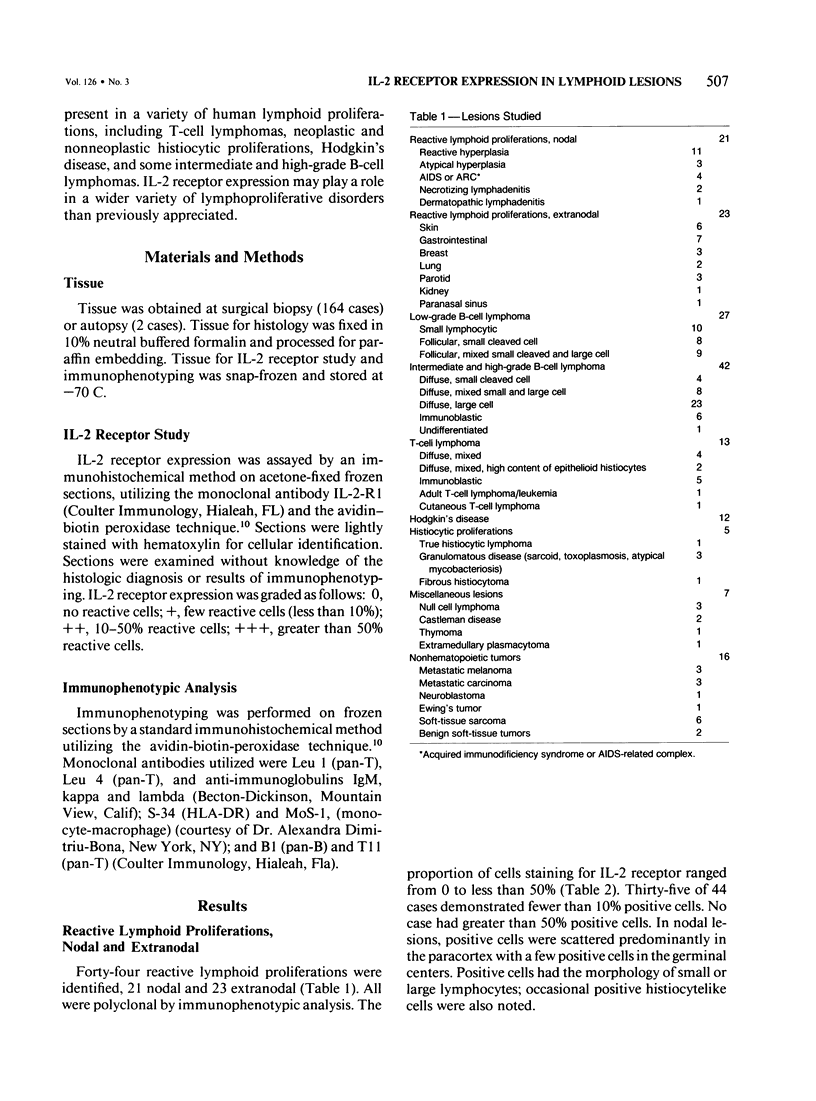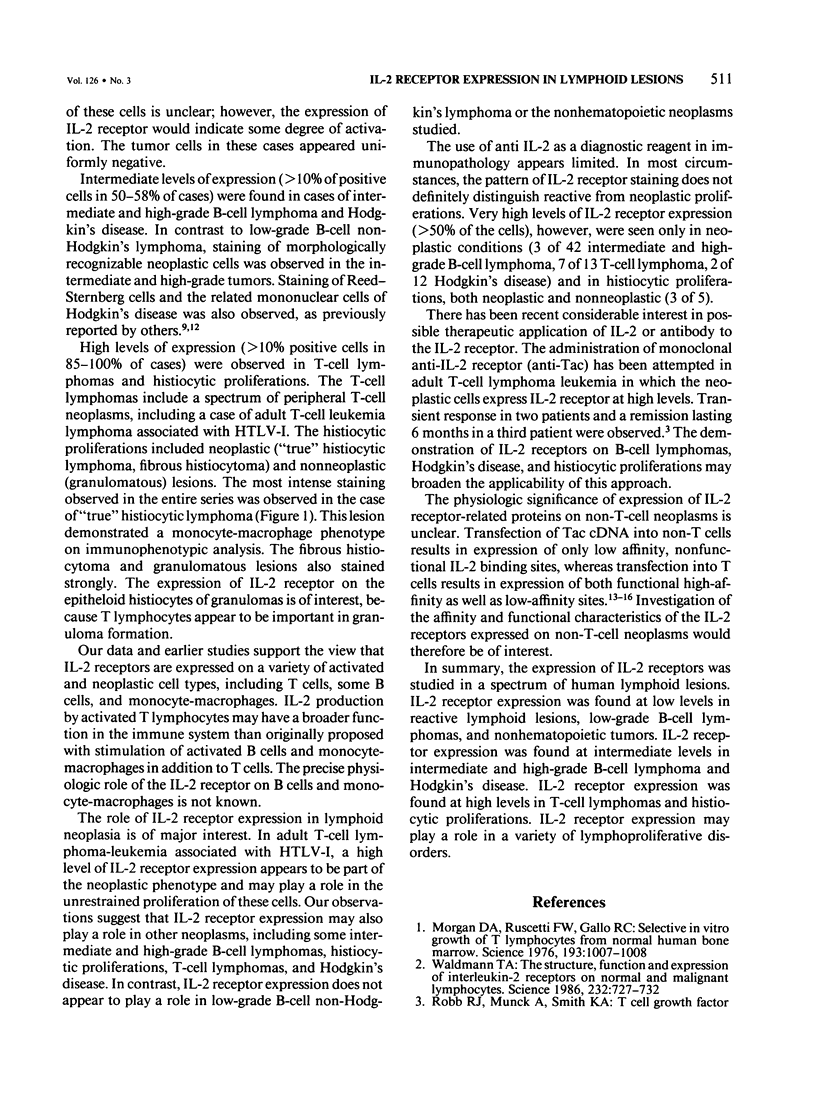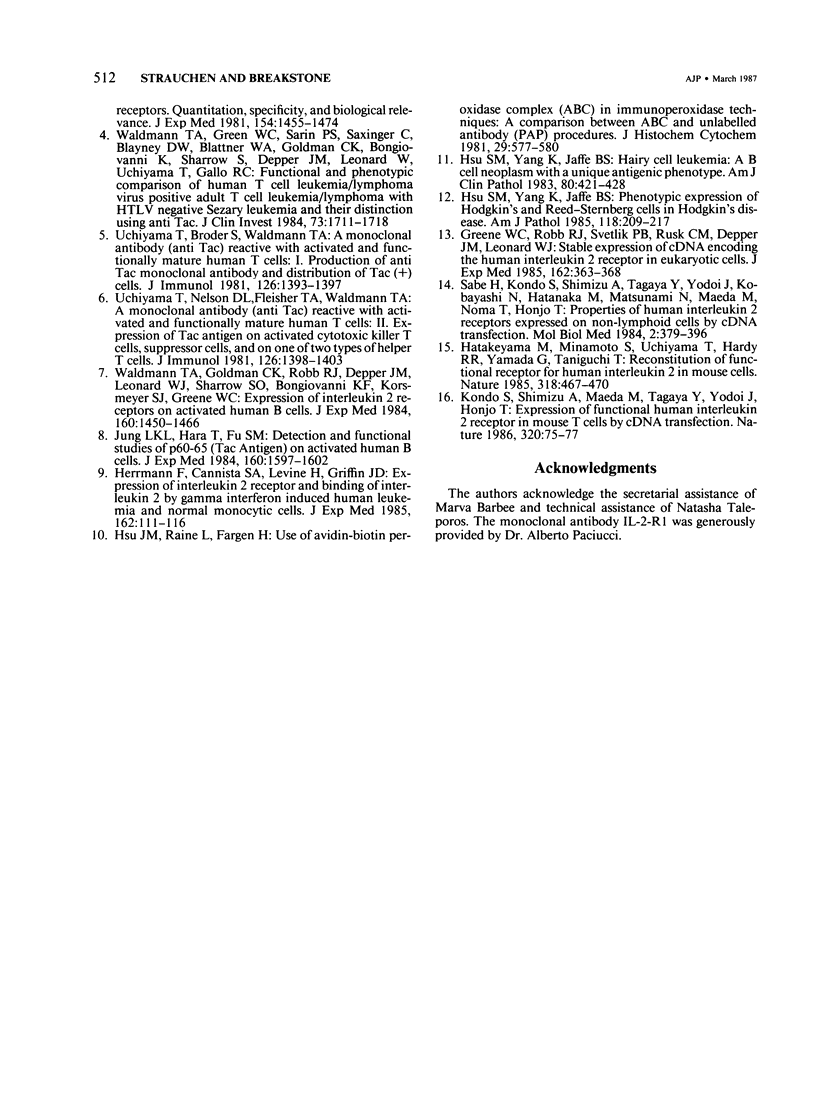Abstract
Interleukin-2 (IL-2) receptor expression is a feature of T-cell activation and T-cell neoplasia. Expression of the IL-2 receptor in human lymphoid lesions was studied in a series of 166 immunophenotyped cases, including nodal and extranodal reactive lymphoid proliferations (44 cases), low-grade B-cell lymphomas (27 cases), intermediate and high grade B cell lymphomas (42 cases), peripheral T-cell lymphomas (13 cases), Hodgkin's disease (12 cases), histiocytic proliferations (15 cases), nonhematopoietic tumors (16 cases), and miscellaneous lesions (7 cases). Low levels of receptor expression were seen in reactive lymphoid lesions, low-grade B-cell lymphomas, and nonhematopoietic tumors (20%, 7%, and 25% of cases, respectively, with greater than 10% positive cells). High levels of receptor expression were seen in cases of peripheral T-cell lymphoma and histiocytic proliferations (86% and 100% of cases, respectively, with greater than 10% positive cells). Intermediate levels of expression were seen in Hodgkin's disease (including Reed-Sternberg cells) and some cases of intermediate and high-grade B-cell lymphomas (58% and 50% of cases, respectively, with greater than 10% positive cells). IL-2 receptor expression is not confined to T-cell neoplasia, but is also a feature of neoplastic and nonneoplastic histiocytic proliferations, Hodgkin's disease, and some intermediate and high-grade B-cell lymphomas. Biologic and therapeutic implications are discussed.
Full text
PDF






Images in this article
Selected References
These references are in PubMed. This may not be the complete list of references from this article.
- Greene W. C., Robb R. J., Svetlik P. B., Rusk C. M., Depper J. M., Leonard W. J. Stable expression of cDNA encoding the human interleukin 2 receptor in eukaryotic cells. J Exp Med. 1985 Jul 1;162(1):363–368. doi: 10.1084/jem.162.1.363. [DOI] [PMC free article] [PubMed] [Google Scholar]
- Hatakeyama M., Minamoto S., Uchiyama T., Hardy R. R., Yamada G., Taniguchi T. Reconstitution of functional receptor for human interleukin-2 in mouse cells. Nature. 1985 Dec 5;318(6045):467–470. doi: 10.1038/318467a0. [DOI] [PubMed] [Google Scholar]
- Hsu S. M., Raine L., Fanger H. Use of avidin-biotin-peroxidase complex (ABC) in immunoperoxidase techniques: a comparison between ABC and unlabeled antibody (PAP) procedures. J Histochem Cytochem. 1981 Apr;29(4):577–580. doi: 10.1177/29.4.6166661. [DOI] [PubMed] [Google Scholar]
- Hsu S. M., Yang K., Jaffe E. S. Hairy cell leukemia: a B cell neoplasm with a unique antigenic phenotype. Am J Clin Pathol. 1983 Oct;80(4):421–428. doi: 10.1093/ajcp/80.4.421. [DOI] [PubMed] [Google Scholar]
- Hsu S. M., Yang K., Jaffe E. S. Phenotypic expression of Hodgkin's and Reed-Sternberg cells in Hodgkin's disease. Am J Pathol. 1985 Feb;118(2):209–217. [PMC free article] [PubMed] [Google Scholar]
- Jung L. K., Hara T., Fu S. M. Detection and functional studies of p60-65 (Tac antigen) on activated human B cells. J Exp Med. 1984 Nov 1;160(5):1597–1602. doi: 10.1084/jem.160.5.1597. [DOI] [PMC free article] [PubMed] [Google Scholar]
- Kondo S., Shimizu A., Maeda M., Tagaya Y., Yodoi J., Honjo T. Expression of functional human interleukin-2 receptor in mouse T cells by cDNA transfection. Nature. 1986 Mar 6;320(6057):75–77. doi: 10.1038/320075a0. [DOI] [PubMed] [Google Scholar]
- Morgan D. A., Ruscetti F. W., Gallo R. Selective in vitro growth of T lymphocytes from normal human bone marrows. Science. 1976 Sep 10;193(4257):1007–1008. doi: 10.1126/science.181845. [DOI] [PubMed] [Google Scholar]
- Sabe H., Kondo S., Shimizu A., Tagaya Y., Yodoi J., Kobayashi N., Hatanaka M., Matsunami N., Maeda M., Noma T. Properties of human interleukin-2 receptors expressed on non-lymphoid cells by cDNA transfection. Mol Biol Med. 1984 Dec;2(6):379–396. [PubMed] [Google Scholar]
- Uchiyama T., Broder S., Waldmann T. A. A monoclonal antibody (anti-Tac) reactive with activated and functionally mature human T cells. I. Production of anti-Tac monoclonal antibody and distribution of Tac (+) cells. J Immunol. 1981 Apr;126(4):1393–1397. [PubMed] [Google Scholar]
- Uchiyama T., Nelson D. L., Fleisher T. A., Waldmann T. A. A monoclonal antibody (anti-Tac) reactive with activated and functionally mature human T cells. II. Expression of Tac antigen on activated cytotoxic killer T cells, suppressor cells, and on one of two types of helper T cells. J Immunol. 1981 Apr;126(4):1398–1403. [PubMed] [Google Scholar]
- Waldmann T. A., Goldman C. K., Robb R. J., Depper J. M., Leonard W. J., Sharrow S. O., Bongiovanni K. F., Korsmeyer S. J., Greene W. C. Expression of interleukin 2 receptors on activated human B cells. J Exp Med. 1984 Nov 1;160(5):1450–1466. doi: 10.1084/jem.160.5.1450. [DOI] [PMC free article] [PubMed] [Google Scholar]
- Waldmann T. A., Greene W. C., Sarin P. S., Saxinger C., Blayney D. W., Blattner W. A., Goldman C. K., Bongiovanni K., Sharrow S., Depper J. M. Functional and phenotypic comparison of human T cell leukemia/lymphoma virus positive adult T cell leukemia with human T cell leukemia/lymphoma virus negative Sézary leukemia, and their distinction using anti-Tac. Monoclonal antibody identifying the human receptor for T cell growth factor. J Clin Invest. 1984 Jun;73(6):1711–1718. doi: 10.1172/JCI111379. [DOI] [PMC free article] [PubMed] [Google Scholar]
- Waldmann T. A. The structure, function, and expression of interleukin-2 receptors on normal and malignant lymphocytes. Science. 1986 May 9;232(4751):727–732. doi: 10.1126/science.3008337. [DOI] [PubMed] [Google Scholar]



